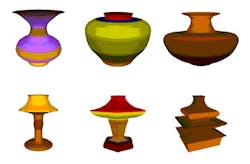3-D virtual objects created by hand
A design tool that enables people to create virtual 3-D objects with their bare hands by using the Microsoft Kinect camera is to be comercialized byZeroUI.
ZeroUI's technology is based on National Science Foundation funded research from Purdue University by Dr. Karthik Ramani, Purdue University's (West Lafayette, IN, USA) Donald W. Feddersen Professor of Mechanical Engineering and his research group.
Dr. Ramani's group won the prestigious "all conference best paper" award for the work, which was presented at the ASME 2012 International Design Engineering Technical Conferences and Computers and Information in Engineering Conference in Chicago. Several patents are pending based on the research.
"(The tool) allows people to express their ideas rapidly and quickly using hand motions alone. You don't have to be an engineer or an accomplished artist to use this. You can be a kid," says Dr. Ramani, who is also the co-founder and chief scientist of ZeroUI.
Vision Systems Design first reported on the development of the technology in an on-line article "Handy-Potter enables users to create 3-D objects with their hands" in August this year.
Related articles from Vision Systems Design that you might also be interested in reading.
1.Kinect API makes low-cost 3-D imaging systems attainable
Microsoft's Kinect is stirring up new interest in 3-D imaging due to its low cost and 'hack-ability' by novices and experts alike.
2.3-D wand helps technicians effect auto repairs
Guidelight Business Solutions (Austin, TX, USA) has developed a 3-D vision system for Matrix Electronic Measuring (Salina, KS, USA) that delivers precise measurements of a vehicle's body and engine.
3.Software transforms images and video into 3-D
An engineer from the University of Illinois at Urbana-Champaign (Champaign, IL, USA) working with software developers at Microsoft Research has developed an algorithm that can automatically transform 2-D single images, as well as 2-D video sequences, into 3-D.
Vision Systems Design magazine and e-newsletter subscriptions are free to qualified professionals. To subscribe, please complete the formhere.
-- Dave Wilson, Senior Editor,Vision Systems Design
